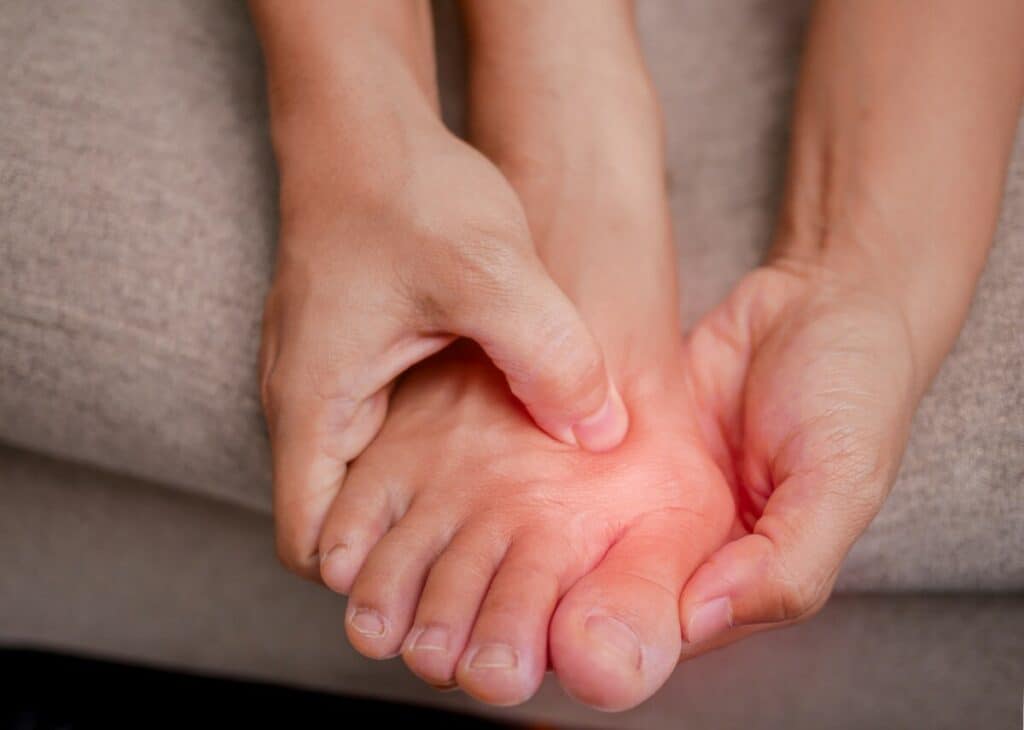Bone Spur on the top of the foot
- Best Asics Shoes for Flat Feet - October 25, 2024
- Best Running Shoes for Flat Feet - October 22, 2024
- Posterior Tibial Tendonitis - October 21, 2024
What is a Bone Spur?
A bone spur (osteophyte) is a small growth of additional bone that occurs at the end of a bone, usually where two bones meet. These bone spurs are commonly seen in the foot due to 30 joints being present. Patients often notice a slight bump appearing on the top of their bone that is firm when pressed. In many cases, a bone spur on top of the foot is pain-free, but in some cases, it can cause significant discomfort.
Bone Spur on the top of the foot
Symptoms
A bone spur on the top of the foot can cause pain when walking on uneven surfaces or running. Tight-fitting shoes that apply direct pressure to the top of the foot can also cause pain from a bone spur.
A bone spur on top of the foot is often accompanied by arthritis, commonly found in the big toe joint. There may be swelling and redness, stiffness in the foot first thing in the morning and a corn or callus on the skin above the bone spur.

Causes
Obesity plays a crucial role in developing bone spurs in the foot due to excess pressure placed on the joints. The repetitive impact from running can increase your risk of bone spur formation, while osteoarthritis is one of the leading causes of bone spur on the top of the foot.
We are more likely to develop a bone spur as we get older, and previous injury to the joint or having flat feet also contribute to developing a bone spur on top of the foot.
Diagnosis
A physical examination by a Podiatrist or a Physical Therapist can identify the symptoms of a bone spur based on palpation and an expected reduced range of movement in the affected joint. However, they may refer for a scan to confirm the diagnosis.
An X-ray is usually sufficient to diagnose a bone spur and to identify any arthritis change within the affected joint space. An MRI may be recommended to exclude any soft tissue injury around the bone spur.
Treatment
There are several treatments to manage a bone spur on the top of the foot, which a Physical Therapist should guide. In the first instance, wide-fitting, cushioned shoes can provide extra comfort and reduce pain levels, and if there is a corn on the skin, a corn pad can be helpful.
A Physical Therapist can perform a physical assessment to identify muscular weaknesses that may be causing poor foot control and overloading the joints affected by a bone spur. A gait analysis can help identify the need for an insole to support the foot’s medial arch.
Anti-inflammatories and ice can help to reduce inflammation and pain levels, while non-impact activities such as swimming and cycling are excellent methods for weight management.
Other treatments include a steroid injection to reduce inflammation levels, or in severe cases, surgery may be performed to excise the bone spur.
Surgery
Most bone spurs are incidental findings on a scan, and it is important to discuss with your therapist if the spur is the cause of your pain or if your pain is driven by a soft tissue structure. In these cases, bone spurs can remain untreated while the soft tissue injury is addressed.
However, some pain can be caused by a bone spur. If conservative treatment is unsuccessful, surgery may be the next best option. Surgery is usually performed arthroscopically, where the bone spur is excised. Recovery from this procedure takes 2-4 weeks. You can typically walk immediately after surgery with minimal restrictions and recommence Physiotherapy.
Running
In our experience, you can continue to run if you have a bone spur once the pain doesn’t affect you while you run. It is unlikely to increase the size of the bone spur, and in many cases, the bone spur is incidental.
However, if you have pain while you run, we recommend stopping until you have a consultation with a foot specialist. This appointment will establish if your pain is caused by the bone spur or another cause, such as a soft tissue injury.
_______________________________________________________________________
We are specialists in treating foot conditions such as Heel Spurs, and you can see one of our Foot and Ankle Specialists in our clinic in Fulham, South West London.
Related Articles
Ankle Taping – Massage for Ankle Pain – Ankle Mobility Exercises
Feel Good, Move Well, Be Better

